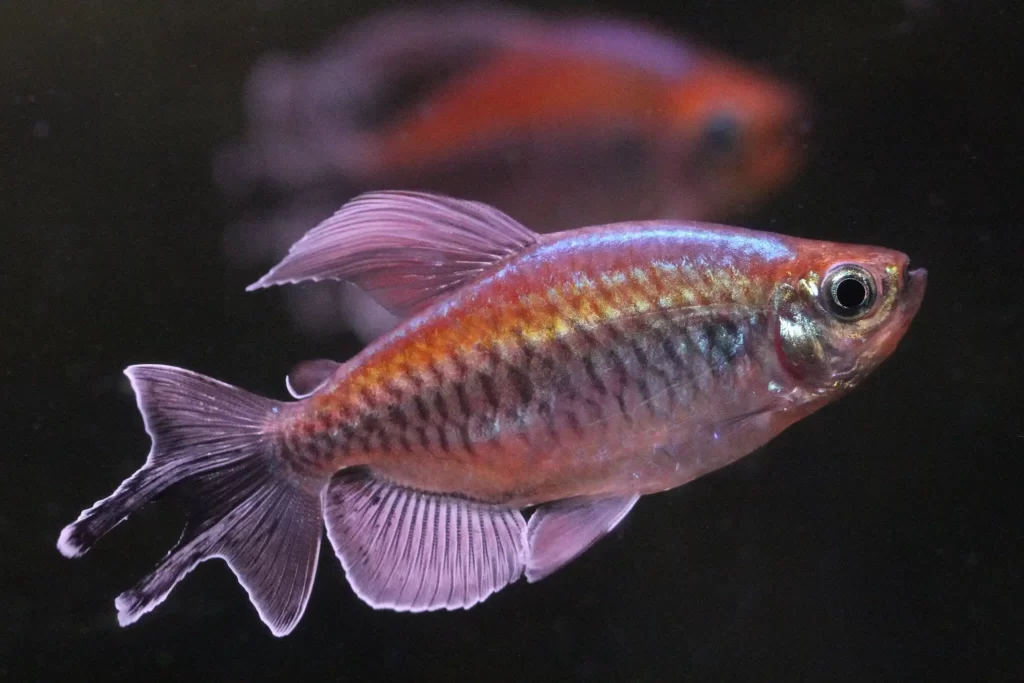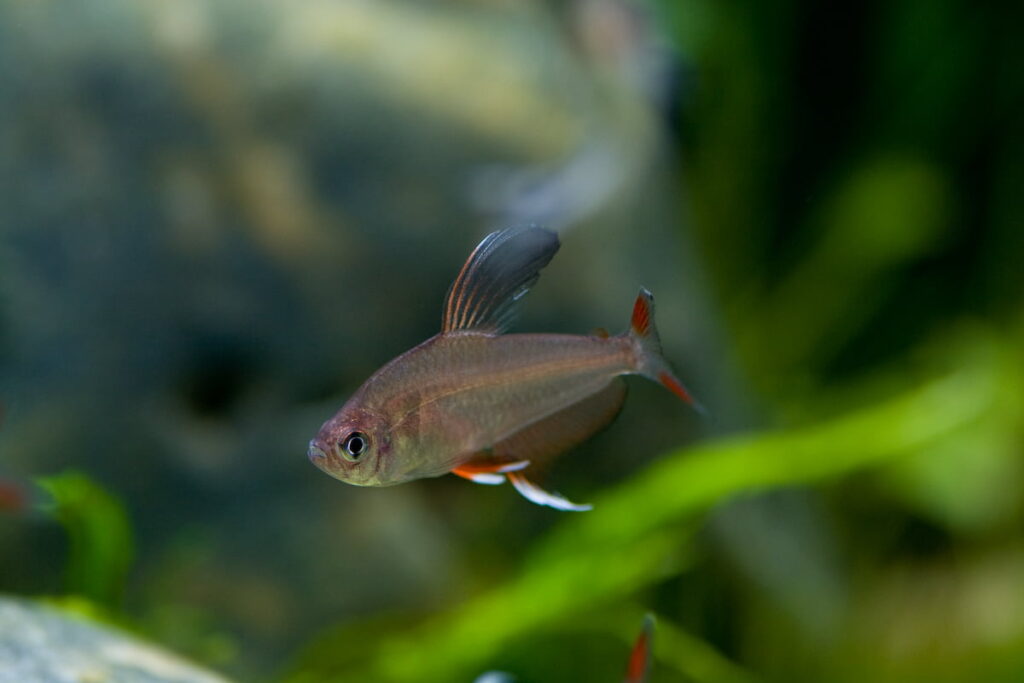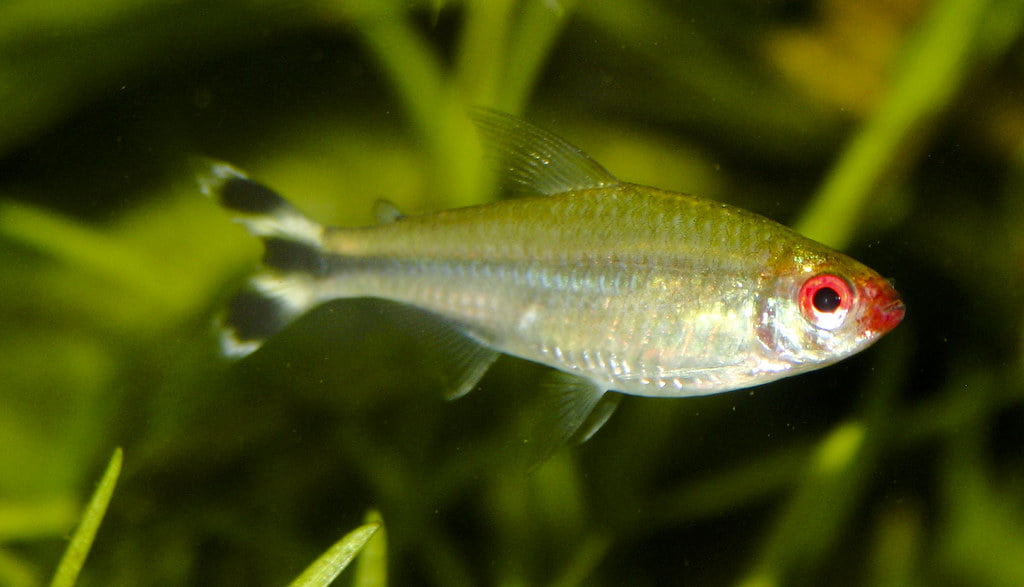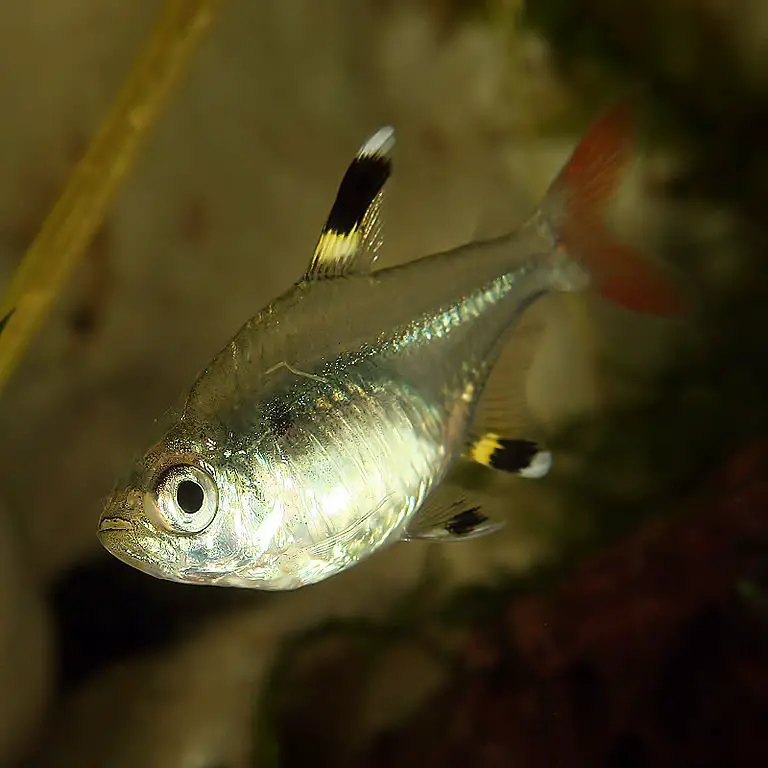When I hear the word “Vampire”, I immediately remember the gorgeousness of white and bloodless characters with fangs in The Vampire Diaries series. What if I say a creature similar to the characters of the series exist? Fascinating, right? The creature that I’m defining is the Vampire Tetra.
Vampires are mysterious but so are Vampire Tetras. Vampire Tetra is a powerful and giant fast-pace fish well-known for its 4 to 5 inches long fangs. With a shimmering silver body and semi-transparent fish, this gigantic fish feeds on Piranhas. Thanks to those enormous fangs, the alternate name for Vampire Tetras is Water wolf, Sabre-tooth tiger fish, Dogteeth tetra, or Dogtooth Characin.
Now, you might be wondering why would anyone want to buy this fish? I agree that Vampire Tetra looks dangerous. But, the indelible appearance and lack of research on this species make them quite rare and unique. You might also find this fish interesting and want to buy it later after reading the description.
Origin, Habitat in the Wild and Distribution of Vampire Tetra
Also known by the scientific name Hydrolycus Scomberoides, Vampire Tetra was first caught by Cuvier in 1819. The scientific name comes from the Greek words “hydro”(water), “lykos”(wolf) and “scombros”(tuna).
In the wild, you can find these species in South America within the Rio de Janeiro Amazonas and its tributaries higher than the mouth of Rio Tapajós additionally as in the Orinoco in the Republic of Venezuela.
They inhabit clean, fast-flowing rivers wherever the water is turbulent, together with rapids and at very cheap of waterfalls. They typically form loose teams and go after smaller fish, however, the majority of their diet consists of piranhas.
About Vampire Tetra
As members of the Cynodontidae family, you can refer them as Cat Fish, Dogtooth cypriniform fish, or Dogteeth characid as well.
There is the reason why this tetra seems dangerous and vicious. From the Vampire Tetra’s appearance to their diet, these tetras are not your normal aquarium fish. To know the intricate details, keep reading further.
Appearance
The reason for the fast-moving nature of this fish is the elongated and streamlined body. Vampire Tetra has a large head and an inverted mouth with holes on the upper jaw to fit those needle-sharp fangs.
This fish can grow up to 4 feet and weigh over 39 pounds in the wild. But, when held captive, Vampire Tetra can grow about 12 inches only.
Availability
All the similar species of Vampire Tetra are collectively known as Payara. The Payara has not been listed in the International Union for the Conservation of Nature(IUCN) so, there is no record of extinction of these species.
Lifespan
Vampire Tetra has an extremely short life span of 6 to 12 months. Since they hunt and feed a lot, they also excrete a lot of waste. The nitrogenous waste might be the reason for their short life span.
Price
Vampire Tetra can cost from $80 to $200. The aquarium-sized specimens are quite rare. The shipping cost from South America may be high due to the size they take. You might find it on sale sometimes.
Some states and regions have banned these predatory fishes from public or private possession. Therefore, check the Fish and Game Department in your area to be sure that you can keep Vampire Tetra in your home.
Payara: The record holder
In the year 1996, the biggest Payara in the world was found in Venezuela which weighed 39.4 pounds and measured 3.5 feet.
Sexual Difference
You might find it quite amusing that it is quite difficult to identify male vampire tetras from the female. That being said, the sexual difference unknown.
Social Behavior and Tank-mates
Vampire Tetras are very aggressive that they even frighten Piranhas. However, these species are slightly less aggressive in aquariums. By analyzing their size, you would probably already know that they will need a large tank.
In your tank, you’ll be able to solely keep vampire tetra within the school of half a dozen. But, they will be aggressive towards tank mates and can not survive in a jam-packed setting. So, it’s better to stay these species separately.
However, you can keep other larger fish such as a Paxu or Large Catfish. The tetras are surely a threat to smaller and slower swimmers.
Difficulty Level
Vampire tetras are not like your regular tetras. Hence, I would definitely say that these tetras are quite challenging to care for. Some might say the fish difficult. However, considering a few things can absolutely make it easier.
The basics to keep in check before purchasing the Vampire Tetra are large space, food, water quality, and oxygen.
It is still a mystery that Vampire Tetras cannot survive long in aquariums. Some cases of the tetras have lived up to 6 months and some also up to 2 years.
Therefore, in order to prevent these species from getting diseases during their short lifespan, a proper stress-free environment that is similar to their natural habitat should be provided.
Caring for Vampire Tetras
Vampire tetras are the sort of fish you need to think about extensively before you buy them. This is because once you purchase the tetras, you cannot back down. You will need to provide every necessary requirement such as tank, water, diet, and quality environment.
If you are not up for this, it is pointless to purchase this kind of tetras. Tetras like these are predatory species but once you purchase them, they become a part of you. Hence, you will need to be ready.
Tank Size
For a normal tetra, you might get away using smaller tanks such as a 10-gallon. But for a vampire tetra, you will need at least the minimum tank size is 500 gallons.
The tetra will need a lot of open space as they swim fast. Especially in the middle part of the tank.
Lightings
The ornamentation ought to be the smallest with moderate lighting. To bring out the illuminating color of the fish, the tank ought to either be dark or the edges and back of the tank should be painted black.
The bright light can cause stress.
Decorations and Substrate
Unlike other tetras, the vampire tetras are not fond of dense aquatic vegetation. Hence, the decoration should be minimal.
You can, however, provide driftwood type caves for a retreat. You can still you any kind of substrate you want.
Vampire Tetra Diet
You can already tell by learning concerning the large fangs that vampire Tetras are carnivorous piscivores. These beasts prefer live fishes over dead ones. they typically opt for smaller specimens like trout, shrimp, and earthworms however they’ll conjointly prey on Piranhas as I had mentioned earlier. That’s the case within the wild.
In aquariums, it’s best to coach Vampire Tetras to eat non-living food like frozen smelt, silversides, squids and mackerels. These species want a varied diet to soak up the mandatory nutrients. you’ve got to feed them many times per day and therefore the amount of food ought to be augmented as per their size
Feeding and diet of the vampire tetra are different than the other tetra diet.
Water Quality Concerns
Vampire Tetras need wonderful water quality that is well aerated and filtrate properly. Since these species are sensitive to poor water quality, water has to be modified regularly. These fish discharge plenty of waste thanks to that accumulation of nitrites, ammonia, nitrates, and phosphate takes no time.
So, thirty to 50% weekly water changes are extremely suggested. As the vampire tetras will have a different environment than in the wild, you need to do whatever you can to make them feel comfortable.
Temperature
The temperature ought to be at the vary of 75 to 82° F. This has to stay stable at any cost.
pH and Hardness
The pH maintains the acidity of the water. In most cases, tetras need more acidic water. But the vampire tetras need a pH level of 6.0 to 8.0.
The hardness should range from 2 to 25 dGH.
Filtration
Your tank will get polluted due to the development of fish wastes, accumulation of nitrites, ammonia, nitrates, and phosphate. Using a filter will provide you a good help to remove these toxins.
Especially for vampire tetras, you will need a strong filter. This is important because even the slightest changes can cause your vampire tetras to cause distress in the tank. Leading this to the death of the tetras.
Filtration can help to increase the nitrogen cycle in the tank removing any kind of waste you cannot.
Breeding
Vampire Tetras are migratory fish that migrate from lakes to large rivers for breeding and feeding purposes. Because of the limited room, it is difficult to breed them in an aquarium. There is no record of the reproduction of Vampire Tetra in captivity.
Vampire Tetra Fish Diseases
Vampire Tetras, as with most fish, are vulnerable to diseases. A few of these include skin flukes, parasitic infestations, ichthyobodo infection, parasitic infestations, bacterial diseases, and bacterial disease.
Aquarists ought to learn about can tank diseases. Knowing the symptoms and identifying and handling them early makes a huge difference.
What a sight!
Vampire Tetras are ferocious game fishes. In recent years, this fish has gained popularity in the aquariums, both public and private. The mouth of Vampire Tetra is what sets them apart from all other game fishes. Trust me, the vibrant silver body gliding in the dark background and those long piercing fangs would really make you say “what a sight”. Even though Vampire Tetra lives for a short period of time, they are really worth purchasing and admiring.
Image Reference: https://www.youtube.com/watch?v=8_6mGvCcxL4




